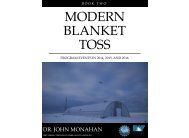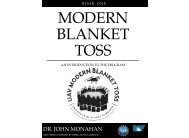Modern Blanket Toss: Findings and Observations
This book is the last in a series of three covering the National Science Foundation awarded Modern Blanket Toss project. In this book are the evaluation findings for each of the three years as well as observations from Modern Blanket Toss staff.
This book is the last in a series of three covering the National Science Foundation awarded Modern Blanket Toss project. In this book are the evaluation findings for each of the three years as well as observations from Modern Blanket Toss staff.
Create successful ePaper yourself
Turn your PDF publications into a flip-book with our unique Google optimized e-Paper software.
FINDINGS AND ANALYSIS<br />
The evaluation addresses three primary questions:<br />
1) How does participation in <strong>Modern</strong> <strong>Blanket</strong> <strong>Toss</strong><br />
activities impact students’ likelihood to pursue STEM<br />
careers?<br />
2) How does participation in the <strong>Modern</strong> <strong>Blanket</strong> <strong>Toss</strong><br />
project impact students’ academic performance?<br />
3) What factors contributed to or hindered the<br />
achievement of these two short-term outcomes?<br />
The evaluation uses quasi-experimental design to address questions 1 <strong>and</strong><br />
2: students from the four Upward Bound communities participating in the<br />
project will serve as the test group, <strong>and</strong> students from the remaining six<br />
Upward Bound communities will serve as a control group. The evaluation<br />
will adopt a descriptive design to answer question 3.<br />
To assess students’ satisfaction with <strong>and</strong> engagement in project activities,<br />
each year the evaluation used<br />
1) a pre- <strong>and</strong> post- interview with students who attended the summer<br />
component, <strong>and</strong><br />
2) a pre- <strong>and</strong> post- survey with all participating students. Larson conducted<br />
surveys of Upward Bound site coordinators at the beginning of the<br />
project, after the summer component, <strong>and</strong> at the end of each school<br />
year in order to assess their preparation <strong>and</strong> knowledge of STEM<br />
content.<br />
In the formative stages, evaluation data was used to inform project<br />
development <strong>and</strong> measure factors that may contribute to or hinder the<br />
achievement of short-term outcomes. Formative evaluation data will be<br />
analyzed using parametric <strong>and</strong> nonparametric statistics (e.g., t-tests, chisquares,<br />
analysis of variance [ANOVA]) to measure changes in<br />
underst<strong>and</strong>ing <strong>and</strong> to correlate observed changes with factors -<br />
satisfaction, engagement, prior knowledge <strong>and</strong> interest, local coordinator<br />
preparation - that may have influenced changes in learning, interest <strong>and</strong><br />
self-confidence. Qualitative data was analyzed using content analysis. These<br />
results were used to improve the program materials <strong>and</strong> activities.<br />
Results that indicate changes in the key indicators of likelihood to pursue a<br />
STEM career, <strong>and</strong> changes in key academic indicators, will be used for both<br />
formative <strong>and</strong> summative purposes. Students completed surveys before<br />
<strong>and</strong> after the summer component as well as in the fall <strong>and</strong> spring of each<br />
school year, while academic data (see below) was collected each spring.<br />
Results from program participants will be compared to the control group<br />
annually to inform project development, <strong>and</strong> was compared longitudinally<br />
over the three-year project period to provide summative evaluation<br />
results.<br />
Reports were provided to program staff after major project activities,<br />
annually, <strong>and</strong> at the end of the three-year project. Formal presentations of<br />
ii




